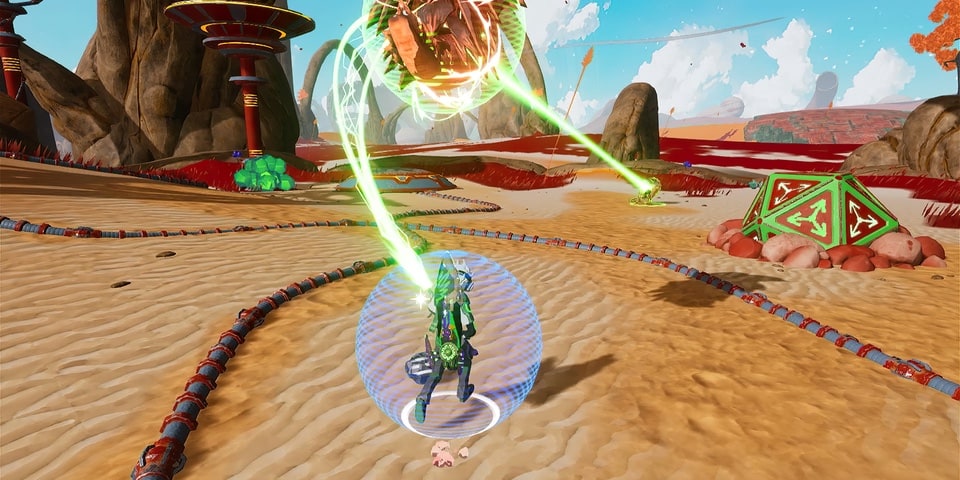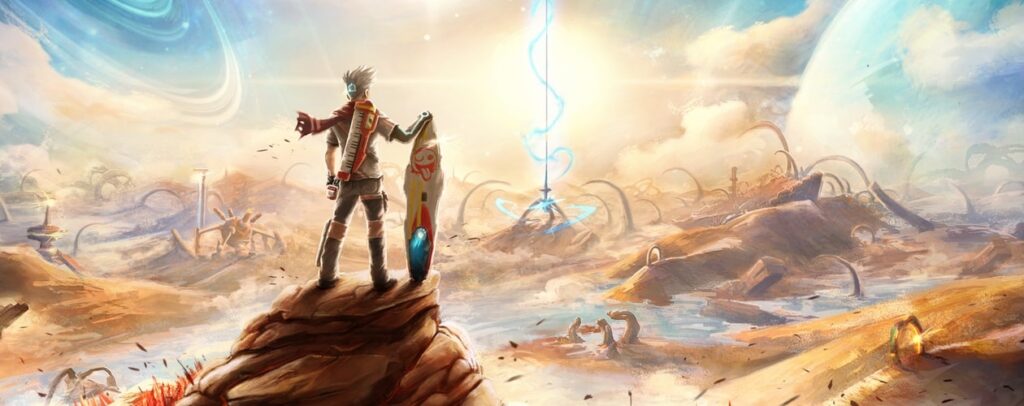Imagine a world where Breath of the Wild was made without the financial force of Nintendo behind it. Imagine that it was made by a team more interested in Star Wars than in Lord of the Rings, and then imagine that rather than the ruins of Hyrule, it’s set in a vast, deserted alien world. The game you’re imagining is Star Overdrive.
If you’re looking for shorthand, Star Overdrive is an indie sci-fi Breath of the Wild. There’s a place where that could be my review, but, this is not that place, so I’d better provide you with a touch more context.
Coming from the team at Caracal Games, and published by indie powerhouse Dear Villagers, Star Overdrive is a third-person adventure where you become Bios, a hoverboard and headphone-toting space farer who’s searching for his lost girlfriend, Nous.
That search takes you to the distant and mostly deserted planet of Cebete, a vast wasteland where metal ruins leer hungrily out of the sand, and the vast bones of ancient creatures lie bleached by the sun. It’s all presented in Breath of the Wild-esque cel-shaded visuals, though there’s much more wasteland here than there ever was in Hyrule. It’s definitely an attractive game, managing to do a lot with a little. The azure blue skies and sandy strata are enhanced by dust particles, gusts of wind and the gleaming rings of nearby planets, and Cebete feels like a real and solid place.
It is a quiet place, though, and the one thing that Caracal Games have absolutely captured is a sense of loneliness, of yearning, and of regret as Bios searches for Nous. Many moments are accompanied by the sound of the wind, with the odd atonal note or two, but you can feel quite alone. It enhances the worry and the desperation that Bios is experiencing though, and gives a unique sense of pace that its inspiration didn’t always have.

Much of the storytelling is delivered via Nous’s personal logs, each tape found amongst the decaying mining drills and forgotten biodomes of an abandoned mining operation. She’s clearly strong and independent, but it’s clear that the weight of her situation is becoming increasingly clear to her.
Our hero doesn’t immediately seem like an ideal choice. There’s a dose of Chris Pratt’s Starlord about Bios, as he rocks a cassette player, keytar-sword and over-ear headphones, and as you explore, you’ll find a series of cassette tapes beyond Nous’s logs. These each hold a classic rock-styled anthem, and while they’re enjoyable enough, they just don’t quite fit with the overarching sound design or the image they’ve constructed for Bios.
Andrea Federici’s excellent soundtrack mixes Vangelis-esque synth with sweeping Satriani-styled electric guitar, and this feels perfectly in tune with the rest of the game. Stylistically, I wanted the additional musical numbers to sit somewhere between Synthwave and Metalcore – something like Gunship or Bad Omens perhaps – but I was left wanting
Bios’s hoverboard is his main source of transportation, and it’s one of the highlights of the game, letting you go boosting, jumping and tricking your way across the sand dunes. Your abilities are fundamentally tied to your hoverboard’s enhancements, and you can craft and build new parts for your board, making it faster, stronger and more manoeuvrable. As part of that, you’ll find a steady stream of races, time trials and collectathons that put your boarding skills to the test, and though they’re occasionally frustrating, overall they do a great job of breaking up the exploration.
Besides your hoverboard, you have a growing set of powers. As with other elements of Star Overdrive, these are heavily influenced by Breath of the Wild. Whether it’s a magnetic push and pull or the ability to freeze time, you have to utilise them to solve puzzles and traverse huge areas, and while they’re slavishly reminiscent of Nintendo’s green-clad hero, there’s enough cleverness and skill to make Star Overdrive feel like its own thing.
Not to sound like a broken record, but the Breath of the Wild comparisons become even more obvious with towers to climb to unlock the map, and shrine-like mining levels that further power up your character. The way they’re implemented may be a riff on Nintendo’s original work, but they’re done well enough that you can forgive it most of its foibles.
Those foibles include lacklustre combat – a chore made all the more annoying by a lack of an enemy lock-on – a few performance stutters, and a camera that is occasionally the wrong side of helpful.
Star Overdrive also makes a terrible habit of showing you the Game Over screen and playing a mournful few notes every time you make a mistake, when really it just means you’ve died and it’s going to reset you relatively near to where you were a moment ago. Caracal really should patch this out immediately because it’s ridiculous and silly, and the longer you play the game, the more it feels like a cruel joke.
